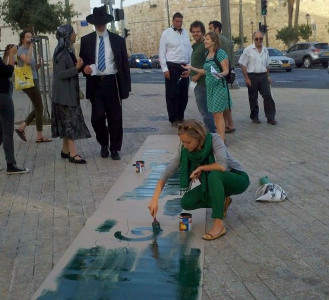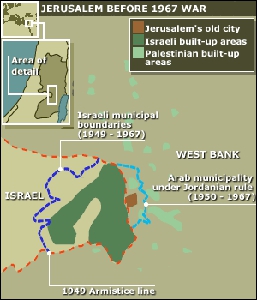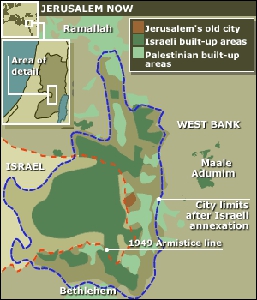“Sometimes doing something poetic can become political and sometimes doing something political can become poetic”.
Francis Alÿs, The Green Line

All That’s Left member painting the Green Line in Jerusalem (A. Daniel Roth)
A surprising operation took place in Jerusalem on the 5th of June: a dozen of mostly young people, all dressed in green, settled down near the Municipality light rail station and invited the passers-by to paint a long strip in green. Initially puzzled, bystanders quickly understood that the significance of the action was going far beyond a simple artistic collective project. In order to visualize what can be found only on maps and is forgotten in everyday life, the collective “All that’s Left” took the initiative to materially represent the 1949 Green Line by painting a small section of it on butcher kraft paper.
June 5th, both Naksa Day and the start of the Six Day War
The date had not been chosen randomly; even if the 5th of June does not have the same signification for Israelis, it is remembered in the Arab collective memory as the Naksa Day, which commemorates the displacement of thousands of Palestinians linked to the Israeli’s victory in the 1967 Six Day War. At the end of the war, Israel deliberately occupied all of East Jerusalem, violating the armistice Green Line of 1948 which confined its rule to the western part of the city. What is nowadays known as the Jerusalem Municipality is an illegal entity in the eyes of international law, and Israel has annexed not only the Old City and East Jerusalem but also parts of the adjacent West Bank and its towns. In order to remind people of this situation, the collective distributed flyers in order to inform curious passers-by of this illegal occupation which becomes more and more passively accepted and integrated.


Jerusalem Municipality before and after 1967 (BBC News website)
Remembering the Green Line
The Green Line, as an abstract concept, is easy to erase and forget, especially when more concrete delimitations such as a wall are built. People walking from West Jerusalem to the Old City do not think, in their everyday life, that they cross a symbolic line, and are entering into an occupied territory. “It’s disturbing to me,” declared Emily Schaeffer, a member of “All That’s Left”, “that the average Israeli or visitor to Israel is able to go about daily life without noticing the occupation and oppression that exist on the other side of the Green Line”. Moreover, according to the flyers distributed by the collective, this erasure is favored by major Jewish Diaspora institutions such as “Birthright” or “MASA”, which encourage a double dynamic of Judaization and de-Arabization, discreetly occurring in the occupied parts of Jerusalem. According to the collective, “erasure is wrong and dangerous because it hides the reality of occupation”, and makes fall into oblivion the multiple daily violations of human rights, such as the houses demolition, the undemocratic military laws or the discriminations against Arabs, in order to avoid the creation of a Palestinian state and to reunify Jerusalem as a global Jewish city. The aim of the operation was neither to provide a definitive answer to the conflict, nor to claim that the Green Line should be the border between two states, but to raise awareness that “inequality is the real demarcation” in Jerusalem, as affirms Daniel Roth, an activist of the collective.
Francis Aly in 2004 – poetry and politics
The idea of physically painting the Green Line has already been performed in 2004 by Francis Alÿs, the MoMA’s artist who walked around Jerusalem with a leaking can of green paint. “All that’s left” took, without knowing it, the same path of the Belgian artist and even went further by including in their performance the active participation of the Jerusalemites. As Moriel Rothman, a young poet and active member of the collective, explained, they share with Alÿs the belief that poetry can be political through its power to surprise by something not expected. Thanks to “this particular moment, between what is expected and the view of a new thing”, it is possible to arouse curiosity and to makes things emerge from oblivion. Even if everyone does not agree with the positions advocated by the collective, it enables the creation of a dialogue with interested people, while the ones refusing to talk do not have to comply with anything and can simply walk away.
Keeping hope alive
This newly formed collective, active for less than five months and mainly composed of young Jews born in North America, provides a new energy to the fight for equality. The members firmly believe that the role of an active civil society is to strongly fight the dangerous apathy and lethargy that leads to accepting injustices without noticing them. Finally, as Moriel Rothman affirmed, this collective is similar to a “spoon full of water over a fire”: one by one it will not have a big impact, but if a lot of groups do it at the same time, it could have a big impact. Even if some small actions like this one are nothing compared to the power of states and governments, it is important that some groups keep hope and maintain the possibility of dialogue.
Here is a video which describes the action:http://www.youtube.com/watch?v=2KQkjvyMubA&feature=youtu.be
